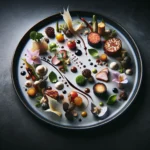Exploring the History of Fine Dining: Tradition and Innovation
Fine dining is not just a meal; it’s a carefully curated experience that blends tradition with innovation. Exploring the history of fine dining allows us to understand the roots of this gastronomic art form and appreciate how it has evolved over the years. The tradition of fine dining can be traced back to ancient civilizations, where elaborate feasts were held to demonstrate power and wealth. As societies evolved, so did the customs and rituals surrounding dining, leading to the establishment of formal dining etiquette and the concept of haute cuisine.
Over time, traditional fine dining has been infused with innovation, as chefs continually push the boundaries of culinary creativity. The fusion of different culinary traditions, the use of cutting-edge cooking techniques, and the emphasis on seasonal and locally sourced ingredients have all contributed to the modern fine dining experience. This harmonious blend of tradition and innovation has elevated fine dining to an art form that tantalizes the senses and delights the palate.
Understanding the history of fine dining provides insight into the meticulous thought and skill that goes into creating a truly exceptional gastronomic experience. By embracing both tradition and innovation, fine dining continues to captivate diners around the world, offering them an opportunity to savor the rich tapestry of flavors, textures, and aromas that define this timeless culinary indulgence.
The Elements of Fine Dining: From Table Etiquette to Culinary Techniques
When it comes to the art of fine dining, there are various elements that come together to create a truly exceptional gastronomic experience. From the moment you take your seat at the table, to the exquisite culinary techniques used to prepare the dishes, every aspect plays a significant role in delivering a memorable dining experience.
One of the essential aspects of fine dining is table etiquette. This includes knowing how to use various dining implements such as the correct use of cutlery, proper napkin placement, and understanding the appropriate way to engage in conversation while dining. Table manners are crucial in creating an atmosphere of sophistication and refinement, adding to the overall enjoyment of the meal.
Another integral element of fine dining is the culinary techniques employed by the chefs. From perfectly executed knife skills to innovative cooking methods, each dish is crafted with precision and artistry. The use of high-quality ingredients, precise cooking times, and creative presentation all contribute to the exceptional nature of fine dining cuisine.
In conclusion, the art of fine dining encompasses a fusion of elements, from impeccable table etiquette to the mastery of culinary techniques. It is a harmonious blend of sensory delights and cultural sophistication, creating a gastronomic experience that is truly unparalleled.
Creating Memorable Experiences: The Psychology of Fine Dining
Creating memorable experiences is the essence of fine dining, where the psychology of the dining experience plays a crucial role. The art of fine dining goes beyond the food itself; it encompasses a carefully orchestrated symphony of ambiance, service, and culinary expertise to captivate all the senses and leave a lasting impression on diners.
From the moment guests step into a fine dining establishment, they are immersed in an environment meticulously designed to evoke a sense of luxury, exclusivity, and indulgence. The use of soft lighting, elegant decor, and the subtle interplay of colors and textures sets the stage for an unforgettable gastronomic journey.
The psychology of fine dining delves into the intricacies of human perception and behavior, leveraging principles of sensory appeal and emotional resonance. Every aspect of the dining experience, from the presentation of the menu to the pacing of the meal, is carefully crafted to evoke anticipation, surprise, and delight.
Additionally, the attentive yet unobtrusive service in fine dining establishments is tailored to anticipate and fulfill the needs of the guests, creating a sense of being truly cared for and attended to. This personalized approach fosters a deep emotional connection between the diners and the dining establishment, elevating the experience from a mere meal to a cherished memory.
The culinary artistry in fine dining extends beyond creating delectable dishes; it involves storytelling through food, where each course is a chapter that unfolds with flavors, textures, and visual aesthetics. The element of surprise and innovation in the presentation of dishes engages diners on a psychological level, stimulating their curiosity and sense of exploration.
Ultimately, the psychology of fine dining is about crafting a holistic experience that transcends the act of eating and transforms it into a multi-sensory, emotionally resonant journey. It is an art form that merges culinary mastery with human psychology, creating indelible memories that linger long after the last bite has been savored.




